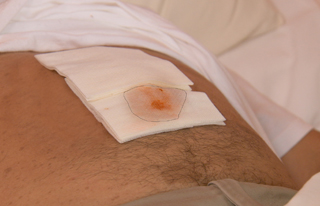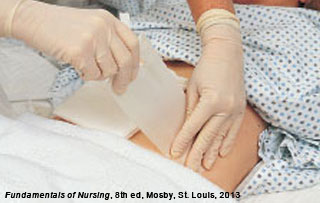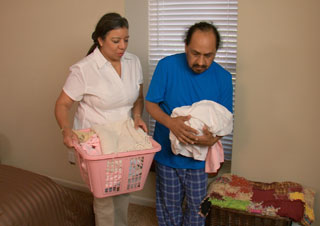What to Do
Look at a Wound

- Follow the doctor’s directions for what to look for and how to clean the wound
- If the person has had surgery, be sure to look at the bandage or wound when the person first comes home from the hospital. That way you will have something to compare with over the next several days. .(Some bandages may need to be left on for a short period of time after surgery (i.e. hip replacement) and therefore you may not look at the actual wound for a few days, you will only look at the bandage.
- Look at the wound/bandage each day. Keep notes in your Care Diary, write down what the wound looks like and any signs of infection.
- Look at the wound when the person tells you there is a change such as more drainage or tenderness increasing.
- If you find a stain (bloody / yellow) on the bandage, use a pen and draw a circle around it the first day. This way you can tell if there is additional drainage each day by checking the original circle.
- If the person complains of not feeling well or becomes less active, check their temperature. The person may have a fever, which is a sign of a wound infection.
Tips for Wound Healing
When you provide care for a person with stitches, follow these tips:
- Avoid hitting the wound on anything; it could cause the wound to break open.
- Do not comb/brush hair or shave over stitches or staples.
- Have the person you provide care for eat a balanced meal, with good sources of protein, fruits and vegetables needed for wound healing.
- Always keep a wound and the sutures, clean and dry, unless otherwise ordered by the doctor.
- Never soak a wound; this means do not let a person bathe in a tub, swim, use a hot tub, or if the person has a hand wound, wash dishes.
- Some doctors let people shower when they have a wound.
- Many doctors suggest use of a certain type of soap such as Dial or Hibiclens®
- Gently cleanse with mild soap and warm water
- Pat dry.
- If you need to keep the wound covered during a shower, tape a layer of plastic wrap over the wound. Tape along all four edges of the plastic wrap to keep water out of the wound. If possible use a hand held shower head and direct water flow away from the wound to lessen the chance of the wound becoming wet.
Wound Care
Always follow the doctor’s directions.

When a doctor prescribes wound care you should know:
- If the wound is to be open to air
- If the wound is to be covered with a dressing or bandage and how often that bandage should be changed (See our lesson on Changing a Gauze Dressing)
- When the stitches or closures will be removed by the doctor
- Special care instructions, such as cleansing, or use of an ointment.

Activity
- Help the person with activities, such as laundering, lifting or moving objects weighing more than 20 pounds to avoid strain on the wound area.
- Do not let the person twist or bear down, putting strain on the sutures and wound. The doctor will give directions on what activities to avoid and for how long